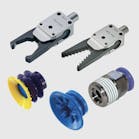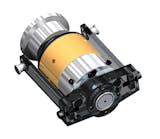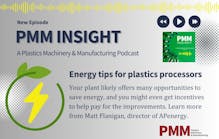A Denmark-based robot maker is expanding its grip on the market with a recent spate of corporate transactions. For OnRobot, which was formed in June through the merger of three automation companies — On Robot, Perception Robotics and OptoForce — cobots represent an untapped market, with demand for accessories such as end-of-arm tooling (EOAT) and tool changers only expected to grow.
"We want to send a signal to the market that we're here to stay and we're here to offer something that's not been seen before," said Kristian Hulgard, GM for OnRobot's Americas division.
In the months since OnRobot launched, it has announced about a half-dozen new products, most for cobots with payloads of up to about 22 pounds. According to a report publicized by the Robotic Industries Association, the market has a lot of potential — while cobots currently account for only 3 percent of robot sales, they're expected to claim a 34 percent share in 2025.
"Collaborative robots have the potential to become the comprehensive standard in industrial automation," OnRobot CEO Enrico Krog Iversen said in a press release announcing some of the company's newest products.
Four products made their debut in June at Automatica in Munich. They include the RG2-FT, Gecko and Polyskin Tactile grippers, as well as a line of force/torque sensors updated from their OptoForce predecessors and known as the HEX-E and HEX-H. And, as part of its latest corporate transaction, an acquisition in September of Purple Robotics, OnRobot added two other products to its portfolio — a dual-vacuum gripper and new tool changer.
Hulgard said the new products are designed to be both intelligent and simple. Industry 4.0 is guiding innovation, as EOAT users demand more from their grippers. "The more sensing technology that you can add to your gripper, that's where the technology is going," he said.
That's true of the RG2-FT gripper. The next-generation version of the RG2 from On Robot, it's equipped with new sensors that allow it to detect and adjust its grip; it can even detect parts without touching them. Designed for precision assembly work and pin insertion, it handles workpieces more safely, because its sensors ensure that it doesn't drop parts. It's compatible with lightweight robots and cobots from Universal Robots and Kuka.
Hulgard foresees a future in which cobots can collect data during part-picking applications. For instance, he said, some grippers already can check the weights of parts as they handle them; complete automation of quality-control processes is just within reach.
He cited the Gecko gripper as a step forward in the evolution of EOAT. Inspired by the namesake lizards, which have sticky pads on their feet, the Gecko grippers feature millions of fine fibers that adhere to the part they're holding. The animals are land-based, but the concept is out of this world — OnRobot licensed it from the NASA Jet Propulsion Laboratory.
Compatible with technologies from Universal Robots and Kawasaki, the Geckos can handle large, flat parts, as well as perforated and porous workpieces. Unlike other EOAT designed for such tasks, they do not require compressed air.
The Gecko's payload capacity depends on the material it's being used to grip; for acrylic, the maximum load is about 9 pounds, or about 2.5 pounds if the Gecko is equipped with an optional, automatic cleaning system. The gripper's pads are effective for between about 50,000 and 100,000 cycles.
The adhesive gripping technology is new to the market, Hulgard said. "They have a tool that they haven't had before. It opens some doors."
Like the Geckos, the Polyskin Tactile gripper also is compatible with Universal Robots and Kawasaki technologies. It features two fingers that can be individually aligned. The tip of each finger has integrated sensors that precisely measure the surface of the part the cobot is handling, allowing the cobot to work effectively with fragile and irregularly shaped parts.
The latest iteration of the OptoForce HEX force/torque sensors features a number of upgrades. The sensors have built-in overload protection that's 20 percent lighter than previous versions and a cable holder with an integrated screw. With these features, users can set up the EOAT about 30 percent more quickly; previously, they had to mount overload protection separately. In addition, an improved sealing ring better protects the HEX sensors against water and dust.
Both the HEX-E and HEX-H sensors weigh about 8.6 ounces and measure about 1.5 inches by 2.8 inches.
Two other product additions come by way of the International Manufacturing Technology Show in September in Chicago, where OnRobot announced its acquisition of Purple Robotics.
Founded by three former Universal Robots product developers, Purple Robotics established a reputation for its vacuum gripper. Its expertise is behind the release of OnRobot's VG10 dual-vacuum gripper, an add-on that effectively provides two hands to one robot arm. The gripper can gently and efficiently lift items of different sizes and shapes weighing up to 22 pounds. It is compatible with a wide range of lightweight robots from all robot manufacturers.
The Purple Robotics gripper has an integrated electric pump, meaning it doesn't need the hoses, compressed air and cables that typically accompany other grippers. It takes less than 30 minutes to install.
In addition to the new EOAT, OnRobot is introducing a tool changer from Purple Robotics, which developed the product shortly before the company joined OnRobot. Weighing in at 7 ounces, the Quick Changer lets operators change EOAT in just seconds. It has no sharp edges, minimizing the risk to operators, and it's compact, minimizing stress on robot joints. It releases EOAT easily and automatically positions new tools with a repeatability to within 0.02mm.
The Quick Changer has a maximum permissible force of about 90 pounds and a maximum permissible torque of 50 Newton-meters. Like the Purple Robotics dual-vacuum gripper, it has a payload capacity of 22 pounds.
Taken together, the new products represent an exponential increase in the portfolio OnRobot inherited from its predecessor, On Robot. But, Hulgard said, it's just a start.
"Going forward, what you can expect to see from OnRobot is quite an aggressive acquisition strategy," he said. "We want to be the guy to go to when you have a collaborative application."
Karen Hanna, copy editor
Contact:
Contact: OnRobot Americas Dallas, 469-442-9370,
Karen Hanna | Senior Staff Reporter
Senior Staff Reporter Karen Hanna covers injection molding, molds and tooling, processors, workforce and other topics, and writes features including In Other Words and Problem Solved for Plastics Machinery & Manufacturing, Plastics Recycling and The Journal of Blow Molding. She has more than 15 years of experience in daily and magazine journalism.








